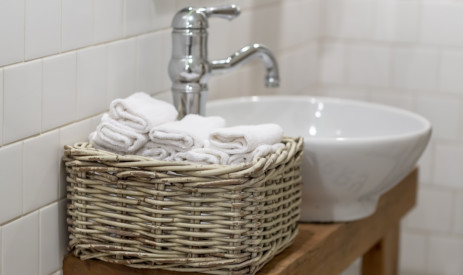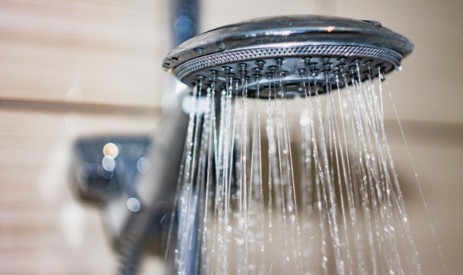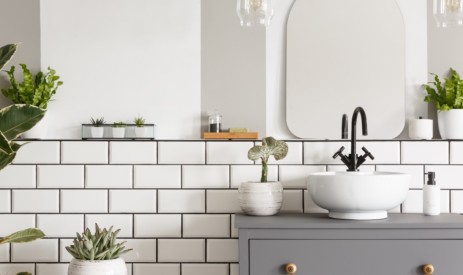Ultimate Guide: How To Clean Your Bathroom, From Grout To Grime
For most of us, cleaning the bathroom is a drag at best – but who doesn’t like stepping into a sparkling clean bathroom?
Read on for a step-by-step guide to creating a bathroom that supports your sanitation and sanity.
During your daily visit:
- Leave the bathroom window open for an hour a day to let the fresh air in
- Spot-clean toothpaste and makeup splatters from the mirror and sink
- Hang a squeegee in the shower and wipe down the walls after every shower
- After bathing or showering, run the fan or leaving doors and windows open for ten minutes
- After a bath, rub down nearby surfaces with a towel
- After a bath or shower, remove hair and soap scum from around your bath drain with a piece of toilet paper
- Close the lid when you flush the toilet
- Store a small handheld vacuum in or near the bathroom for loose hair, dust and dry spills
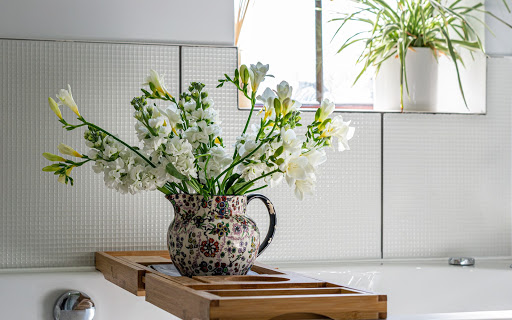
Weekly bathroom makeover – the time has come…
First, put on some music and get your tools ready. You will need:
- Washing-up gloves
- Cloths (we recommend E-cloths, microfiber cloths that can be used with just water)
- Paper towels
- Double-sided sponge (we recommend LoofCo washing-up pad)
- An old cleaning toothbrush
- An old plastic bag
- Squeegee
- Vacuum
- Mop (we recommend the E-cloth bathroom mop)
- 50/50 white vinegar and water mix in a spray bottle
- Extra white vinegar
- Extra bicarbonate of soda
- Floor-cleaning mix – 1 cup vinegar, 1 cup baking soda, 1 tablespoon detergent in a bucket with lots of warm water
- Any other products you’re using
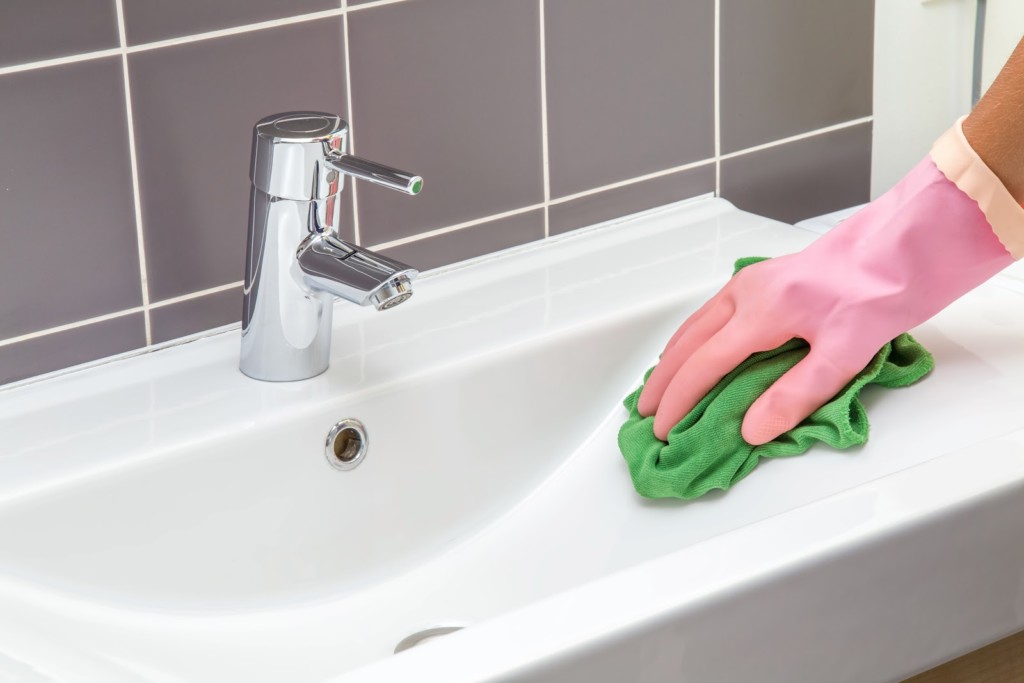
Setting the scene for a clean
- Shut the bathroom windows, plug the bath and run some hot water into it – condensation can dislodge grime. Shut the door and leave for ten minutes.
- Go back in and remove everything from surfaces.
Tip: Run your toothbrush holder through the dishwasher
- For a basic natural clean, spray the shower (including shower walls) bath, sink area and windowsill with 50/50 vinegar-water mix to break down heavy build-up and kill bacteria.
- If you’re using a shop-bought cleaning product, follow the instructions.
Product recommendation: Method and Bio-D
Tip: Wash plastic shower curtains in the washing machine (in warm water) with a few old towels
- To give your bath and sink area a deeper natural clean, first sprinkle bicarbonate of soda on these surfaces, then spray the vinegar-water mix on top. Let that sit for ten minutes before sponging it down with warm water.
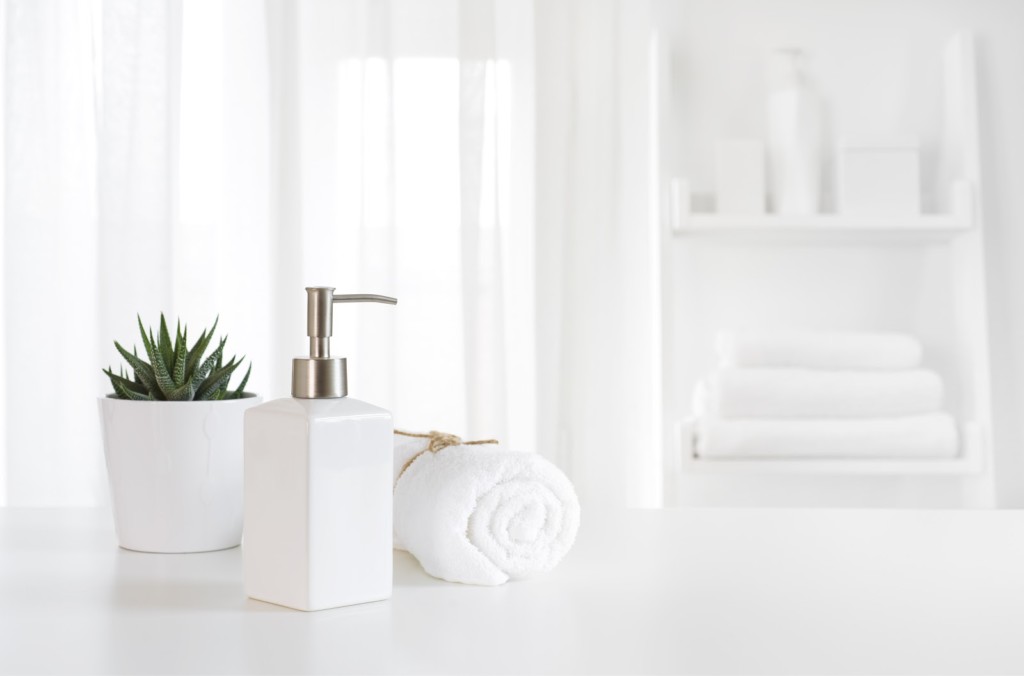
And… it’s on
- Return to the toilet and, using a paper towel, wipe the tank, flusher, lid, rim (top and bottom), base and the area behind the toilet.
- Clean the toilet brush container with another paper towel.
- For a basic natural clean: spray 50/50 vinegar-water your toilet inside the bowl, and also on the toilet seat, lid, and handle. Sprinkle half a cup of bicarbonate of soda in the bowl.
- Place the toilet brush in the bowl and let it sit for ten minutes.
- If you’re using a toilet cleaner, follow the instructions. Soak the toilet brush in the toilet bowl while you let the product do its thing.
Product recommendation: Daylesford loo cleaner
- Next, spray the bathroom mirror with 50/50 vinegar-water mix or glass cleaner then wipe with a cloth (ideally an E-cloth) using an ‘S’ pattern from top to bottom. Buff out any streaks.
Product recommendation: Ecover glass cleaner
- Spray and wipe the windowsill with 50/50 vinegar-water mix or all-purpose cleaner.
- Turn back to the bath.
- If you’ve sprinkled bicarb on it, scrub it into a paste using a sponge. Leave it a further ten minutes before wiping away the lot with a cloth and water.
- If you’re using a shop-bought cleaning product, follow the instructions.
- Note: If your bath is enamel, never use abrasive cleaning products or
tools. - Spray shower walls from top to bottom (and the floor) with vinegar-water mix or your all-purpose cleaner. Wipe down the walls with a squeegee and the floor with a sponge.
Wipe sink with a damp cloth in ‘S’ pattern. - If you’ve sprinkled bicarb around the sink, scrub with a sponge into a paste and leave the paste on for a further ten minutes before wiping away the lot with a cloth and water.
- Clean taps and plugs with vinegar-water mix and your cleaning toothbrush. Polish them with a damp e-cloth.
- For a natural deep clean: use the bicarb sprinkle method as above.
- Turning back to the toilet, remove the toilet brush from the bowl. Sponge the toilet bowl, then flush.
- Still seeing marks? Remove them with a damp pumice stone.
- The floor – clean it last but not least
- Vacuum the whole floor, including any tiles around the bath or shower.
- Mop them with the natural floor-cleaning mix or a shop-bought product.
- Be sure to get all around the sides of your toilet bowl with both the vacuum cleaner and the mop.
Product recommendation: Bio D Floor Cleaner
(Note: If you’ve got marble tiles or wooden floors, clean them with a mild washing-up liquid)
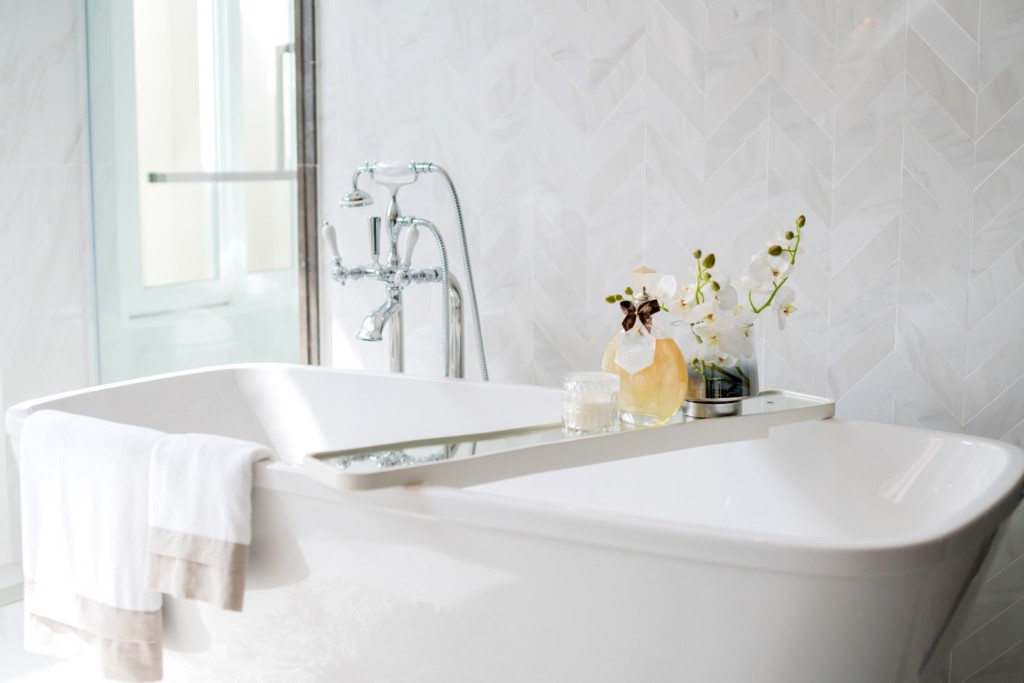
Tackling tiles and grout
- Some tiles – such as stone and marble – should only be cleaned with mild washing-up liquid dissolved in water. Otherwise…
- For a basic natural clean: use a 50/50 water and bicarbonate mix. Let this sit for 30 minutes or overnight before you scrub it with an old toothbrush (or stiff brush) then wipe it away with a damp cloth.
- For hard-to-reach corners, soak a cotton ball in vinegar or all-purpose cleaner and press it into the corners. Wait several minutes then remove the cotton ball and wipe the corner with a damp cloth.
- You’ve probably noticed that grout – the cement paste between them – loves to collect soap scum and black mould.
- For a deep natural clean: use bicarbonate of soda and hydrogen peroxide combo.
- First, sprinkle the bicarb onto grout until it is covered. Then spray with hydrogen peroxide until it is wet, wait ten minutes, scrub, and wipe clean.
Product recommendation: HG Mould Remover Spray
Tip: If you’re using a specialty grout cleaning product, use it sparingly as these can corrode and even slowly destroy your grout.
